What Could Drive Health Care Reform 2025?
It’s important to note that “Health Care Reform 2025” isn’t a single, defined piece of legislation yet. Instead, it represents the potential policy shifts and outcomes influenced by current political dynamics, technological advancements, and the ongoing debate over the future of the US healthcare system. Discussions often center on areas like:
- Modifications to the Affordable Care Act (ACA)
- Changes to Medicare and Medicaid
- Efforts to control prescription drug costs
- Expansion of value-based care models
- Integration of telehealth and digital health
- Addressing healthcare access and equity
Depending on which proposals gain traction, the impacts of Health Care Reform 2025 could be significant and varied.
Potential Winners of Health Care Reform 2025
Predicting specific winners is challenging without concrete legislation, but based on current trends and policy proposals, certain groups or entities might see benefits. Understanding the potential winners of Health Care Reform 2025 helps illuminate the intended goals of various reform efforts.
- Patients with Chronic Conditions: Reforms emphasizing coordinated care and value-based payment models could lead to better-managed chronic diseases, fewer hospitalizations, and improved quality of life. Integrated care systems might thrive under such reforms.
- Rural Patients: Increased investment and policy support for telehealth expansion could significantly improve access to specialists and primary care for individuals in underserved rural areas, reducing travel burden and costs.
- Innovators in Value-Based Care: Healthcare providers and organizations successfully transitioning to models that reward quality and outcomes over volume are likely to prosper under reforms pushing in this direction. This includes Accountable Care Organizations (ACOs) and bundled payment initiatives.
- Manufacturers of Cost-Saving Technologies: Companies developing technologies that reduce overall healthcare spending, such as remote monitoring devices or efficient administrative software, could see increased demand.
For instance, imagine a reform that heavily subsidizes remote patient monitoring for heart failure patients. Hospitals and cardiology groups adopting this technology efficiently could see better patient outcomes and reduced readmissions, potentially lowering costs and increasing revenue under value-based contracts. [Link to a reputable source on value-based care trends]
Potential Losers of Health Care Reform 2025
Conversely, changes designed to benefit some groups may inadvertently create challenges for others. Identifying the potential losers of Health Care Reform 2025 requires considering who might struggle to adapt or whose current models are disrupted.
- Providers Resistant to Change: Healthcare providers clinging to traditional fee-for-service models may face financial pressure if payment structures shift dramatically towards value-based care or capitated payments.
- Certain Healthcare Facilities: Hospitals heavily reliant on high-volume procedures might see revenue decrease if reforms prioritize preventative care and outpatient settings. Rural hospitals, already financially fragile, could face additional strain depending on the specifics.
- Patients Losing Specific Plan Options: Depending on changes to the ACA marketplaces or employer-sponsored insurance regulations, some individuals might find their preferred plans are no longer available or affordable.
- Parts of the Pharmaceutical Industry: Aggressive reforms aimed at controlling prescription drug costs, such as direct government negotiation or price caps, could significantly impact the profitability and research budgets of pharmaceutical companies.
Consider a reform that mandates stricter price controls on certain high-cost drugs. While beneficial for patients, pharmaceutical companies focused heavily on those specific drugs might see significant revenue drops, potentially impacting future R&D investments.
Unpacking the Hidden Costs of Health Care Reform 2025
Beyond the obvious shifts in premiums, deductibles, or provider payments, Health Care Reform 2025 could introduce several less visible costs. These hidden costs of Health Care Reform 2025 can impact the system’s efficiency, innovation, and overall health outcomes in subtle ways.
- Increased Administrative Burden: Implementing new regulations, reporting requirements, and payment models often necessitates significant investment in IT systems, training, and administrative staff for providers and insurers. This isn’t a patient premium cost, but it adds friction and expense to the system.
- Reduced Patient Choice (Potentially): Reforms aimed at streamlining care or controlling costs might inadvertently narrow provider networks or limit access to certain specialized services, even if overall access appears to improve.
- Innovation Slowdown: If reforms create significant financial instability or uncertainty for hospitals, clinics, or life sciences companies, investment in new technologies, treatments, and care models could decelerate.
- Healthcare Workforce Strain: Implementing complex reforms can increase stress and workload for doctors, nurses, and administrative staff, potentially contributing to burnout and workforce shortages. [Link to a source on healthcare workforce challenges]
- Unintended Consequences: Policymaking is complex. Reforms designed to fix one problem can sometimes create unforeseen issues elsewhere in the system, requiring further adjustments and incurring additional costs.
For example, a reform designed to reduce hospitalizations might push more care to outpatient settings. While seemingly positive, this could strain outpatient clinics unprepared for the increased volume or complexity, leading to longer wait times or reduced quality.

Preparing for Potential Healthcare Changes
Given the potential for Health Care Reform 2025 to impact patients, providers, and payers, how can stakeholders prepare?
- Stay Informed: Follow news and analysis from reputable sources regarding proposed policy changes.
- Understand Your Current Coverage: Know your plan’s details, including deductibles, copays, network restrictions, and covered services.
- Engage with Policymakers: Where appropriate, share your perspectives on proposed reforms with elected officials.
- Assess and Adapt (for Providers/Businesses): Evaluate how different reform scenarios might impact your operations, finances, and patient care delivery. Develop strategies to adapt to potential shifts towards value-based care or new payment models.

Conclusion
While the specifics of Health Care Reform 2025 remain fluid, understanding the potential outcomes – who might win, who might lose, and the often-overlooked hidden costs – is essential for navigating the future of healthcare in the US. These potential changes are not just about policies and budgets; they have real-world implications for the health and financial well-being of millions. By staying informed and preparing for potential shifts, individuals and organizations can better position themselves in a changing landscape.




